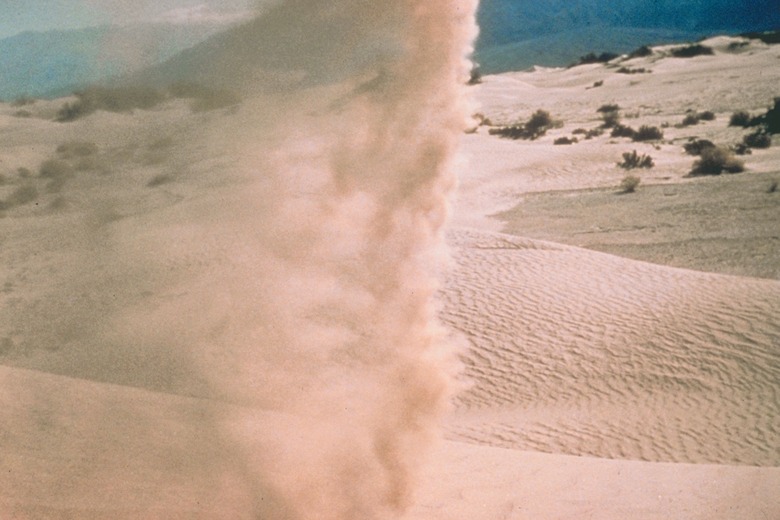Environmental Hazards In The Deserts
Characterized by extended periods of drought and extremes of heat and cold, deserts experience environmental conditions that are dangerous to desert life, including humans.
Newcomers to desert areas need education about the hazards in deserts they may encounter; these hazards vary according to the location and geology of the particular desert.
Climate
Climate
Deserts cover about one-fifth of Earth's land surface. There are four major types of deserts:
1. Hot and dry 2. Coastal 3. Semiarid 4. Cold
Examples of hot and dry deserts are the Sonoran Desert in the U.S., Australia's great central desert, the African Sahara Desert and South America's Atacama Desert. Extreme summer maximum temperatures can reach 43.5 to 49 degrees Celsius (110 to 129 degrees Fahrenheit).
The Namib Desert in southwestern Africa is an example of a coastal desert, which simply means it's a desert on the coast of a water source, usually an ocean. These deserts often have moving sand dunes thanks to the distinctive wind patterns.
Semiarid deserts often have shrubs and brush throughout. Common examples are the deserts of Utah and Montana in the United States along with the deserts in the Nearctic realm. These deserts have hot summers with rainy winters.
Cold deserts exist in the Arctic, Antarctic and Greenland and have snow cover for most of the year. Rainfall in the Sahara and Atacama average less than 1.5 cm (0.6 inches); American deserts average 28 cm (11 inches) yearly. Rainfall can be torrential when it occurs, causing dangerous flash floods and erosion. Strong winds carry sand and dry desert soils, creating damaging dust storms or haboobs.
Geology
Geology
Site-specific geological features present environmental hazards as well. In Arizona, groundwater withdrawal can lead to earth fissures over a mile long, up to 15 feet wide and hundreds of feet deep. Problem soils that expand and contract when wet or dry cause damage to homes and other structures.
Arizona and Egypt share hazardous conditions because of underlying karst formations, or water-soluble rocks that develop caves, depressions, fractures and sinkholes, giving rise to unstable conditions. Earthquakes and volcanism are other hazards that can occur in deserts of the world.
Soil Movements
Soil Movements
The first of the most common desert natural disasters are landslides and mudslides. Landslides happen when slopes are weakened by rainfall, earthquakes or wildfires.
Fast-moving landslides, such as rock falls and avalanches, carry away houses and cover roads. In Saudi Arabia, landslides are considered more devastating than all other natural hazards combined.
Areas of sand dunes are constantly on the move, shifted about by winds. In Egypt, sand dune migration is one of the most serious economical and environmental problems. After rainstorms, debris flows result from runoff waters moving and redepositing soil, plant material, rocks and boulders, and typically are 80 percent solids and 20 percent water. In Arizona, they occur primarily during summer monsoons.
Biological Hazards in Deserts
Biological Hazards in Deserts
Plants and animals with toxic components also present dangers to humans in deserts. Euphorbias that grow in African deserts have caustic, milky sap that can cause temporary or permanent blindness.
Cacti native to North and South American deserts have fierce spines that cause painful punctures and lacerations. Venomous creatures such as snakes, scorpions, spiders and lizards inhabit deserts; their bite or sting can cause human illness or death.
In Africa, hordes of desert locusts destroy vast areas of natural vegetation and croplands. In the American Southwest, a pathogenic, soil-borne fungus causes the disease called valley fever or coccidioidomycosis, which can be fatal.
Tiny, biting sand flies occur during rainy seasons in both Old World and New World deserts. They carry a serious disease called leishmaniasis, which is a significant health threat to U.S. military personnel deployed to areas such as the Middle East, Afghanistan and Africa.
References
- The Arizona Geological Survey: Environmental Geology and Geologic Hazards in Arizona
- University of California Museum of Paleontology: The Desert Biome
- Encyclopedia Britannica: Haboob
- Natural Hazards: Geotechnical and Environmental Hazards in Desert New Cities: A Case Study of El Minnia El Gedida Site, Egypt; Ahmed A. Abdel-Meguid et al.; 1998.
- Developing a Monitoring System for Sand Dunes Migration in Dakhla Oasis, Western Desert, Egypt
- Saudi Geological Survey: Hazards: Geohazards
- Indian Journal of Ophthalmology: Keratouveitis Caused by Euphorbia Plant Sap; Samar K. Basak et al.; 2009.
- Mayo Clinic: Valley Fever
Cite This Article
MLA
Csanyi, Carolyn. "Environmental Hazards In The Deserts" sciencing.com, https://www.sciencing.com/environmental-hazards-deserts-19990/. 19 June 2019.
APA
Csanyi, Carolyn. (2019, June 19). Environmental Hazards In The Deserts. sciencing.com. Retrieved from https://www.sciencing.com/environmental-hazards-deserts-19990/
Chicago
Csanyi, Carolyn. Environmental Hazards In The Deserts last modified August 30, 2022. https://www.sciencing.com/environmental-hazards-deserts-19990/
